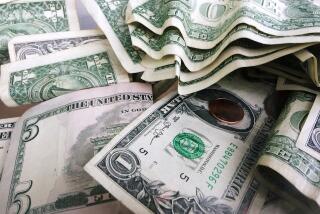A Last-Minute Tax Shelter Worth Considering
- Share via
It’s like an individual retirement account, but in some ways better. It’s one of the few legitimate tax shelters left that you can still pursue this late in the year. And many people who are eligible to have one don’t.
It’s a Keogh plan, and if you have self-employment income, you should consider opening one this week if you don’t have one.
“Basically, anybody who has self-employment income should be looking at setting up a Keogh,” says Edward Rosenson, a tax partner in charge of personal financial planning in the Los Angeles office of the accounting firm Ernst & Young. But many people don’t know about Keoghs because “the publicity by far is in favor of IRAs.”
Sometimes called Super IRAs, Keoghs are tax-deferred retirement accounts that you can set up if you earn self-employment income such as from your own business, professional practice or from a small sideline activity or hobby. If you work for a big corporation by day but moonlight as a screenwriter, painter, carpenter or other self-employed worker, you can put the income from that self-employment into a Keogh.
Keoghs have many of the advantages of IRAs. Contributions are tax-deductible. Earnings accumulate tax deferred until withdrawn, presumably when you retire. Assets can be invested in many of the same instruments allowed in IRAs, such as certificates of deposit, stocks, bonds and mutual funds.
Like an IRA, you can set up a Keogh at a bank, brokerage house or mutual fund. You also can roll over lump-sum distributions from your pension plan, 401(k) company savings plan or other qualified retirement plan into your Keogh.
But Keoghs have some advantages over IRAs. Among them:
* You can put more money into them.
In fact, the limits for annual contributions are far higher than the $2,000 annual limit on IRA contributions. The exact amount depends on which type of Keogh you choose.
In a “profit sharing” Keogh--the most flexible type--you can decide each year whether to contribute and how much, up to 15% of your net profit from your self-employment activity, to a maximum of $30,000.
In a “money purchase” Keogh, you can contribute a fixed percentage of self-employment earnings each year, up to a maximum of 25%, or $30,000. But you must contribute this same amount every year, unless your business shows a loss.
You can also choose a “paired” plan that has features of both profit sharing and money purchase plans. You choose the percentage that you contribute annually to the money purchase portion, and then you can contribute to the profit sharing portion. The total can go up to 25%.
There also are “defined benefit” Keoghs in which you can contribute even more. You’ll need a professional, such as an actuary or accountant, to tell you how much, according to Michael Shuler, a public affairs specialist with the Internal Revenue Service in Los Angeles.
* You have more flexibility on when to contribute.
Like an IRA, you must set up your Keogh by Dec. 31 of the year you will claim deductions for your contribution. But you can wait until you file--April 15 or even later if you get an extension--before actually making the contribution deductible for the previous tax year.
With an IRA, your deadline is April 15, regardless of whether you file for an extension.
* You can save taxes upon withdrawal.
Money you withdraw from an IRA after age 59 1/2 is generally taxed at your regular rate. But if you have contributed for at least five years to a Keogh, were at least 50 years old in 1986 and take your money out of your Keogh in a lump sum after age 59 1/2, you may be able to use a special five-year averaging procedure.
In effect, this allows you to treat the account as if you withdrew the money in equal, smaller amounts stretched over five years. That’s going to lower your tax.
Because of these advantages, if you are leaving a company, consider rolling over your company pension or 401(k) money into a Keogh instead of an IRA.
Another advantage to Keoghs: You can have one and still keep your IRA. And even if you are not eligible for a deductible IRA contribution--because you already have a pension plan through your employer and exceed certain income limits--you can still make deductible contributions into a Keogh.
Also, although you must start withdrawing from your Keogh at age 70 1/2--just like with an IRA--you still can keep contributing after that age as long as you continue to earn self-employment income. IRA contributions are no longer allowed after that point.
Of course, not all is a picnic with Keoghs. There are some drawbacks.
To set up a Keogh, you’ll need some advice from an accountant, attorney or other expert. The process is much more complicated than with an IRA; a lot more paper work is involved. And there are a lot more rules governing how often and how much you must contribute.
Also, if you have employees who work for you in your self-employment business, you must include them in your Keogh, which in effect becomes your business’s pension plan. The Keogh is subject to various rules, including provisions preventing you as owner from benefiting disproportionately compared to your employees.
More to Read
Inside the business of entertainment
The Wide Shot brings you news, analysis and insights on everything from streaming wars to production — and what it all means for the future.
You may occasionally receive promotional content from the Los Angeles Times.










